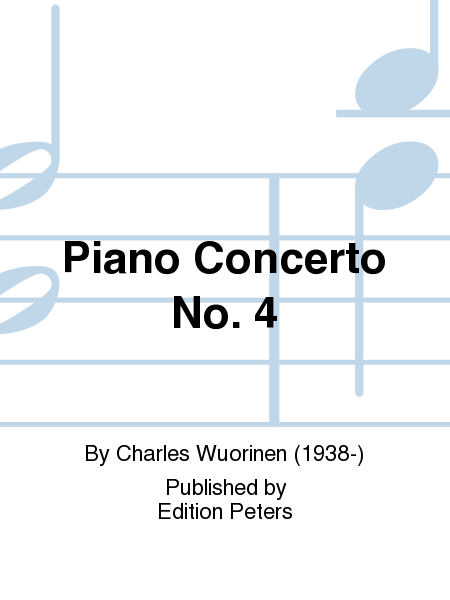Fourth Piano Concerto
2003
Details
Description
SKU: PE.EP68035
2003. Composed by Charles Wuorinen. Piano(s) & Other Instruments (In Ensembl 1.5. Modern. Full Score. Composed 2003. Duration 00:24:00. Edition Peters #EP68035. Published by Edition Peters (PE.EP68035).ISBN 9790300749440.
"Prior to the present concerto, Wuorinen had not written a piece for piano in a solo role since completing his Third Sonata in 1986; his Third Concerto dates from 1983. Nor had Wuorinen ever written a solo vehicle for pianist Peter Serkin, although in the mid-1970s he'd written two works called TASHI, a chamber piece and a kind of concerto grosso, for Serkin's quartet of the same name. The idea for the Fourth Piano Concerto grew out of conversations between Serkin and Wuorinen that took place over several years.
It was Serkin who suggested a Wuorinen commission to Boston Symphony Orchestra Artistic Administrator Anthony Fogg, who proposed the idea to then Music Director Designate James Levine in spring 2002, during planning for Levine's first season as Music Director. Levine immediately embraced the idea, and Wuorinen's piece became one of three new commissions scheduled for premiere under Levine's direction for 2004-05 (the others being John Harbison's Darkbloom, also on this program, and Babbitt's Concerti for Orchestra, premiered this past January). Wuorinen began working on the piece in late spring 2002 and continued, with interruptions, until October of the following year.
The piece is in three large but interrelated sections, marked Part I, Part II, and Part III. The first section is about eleven minutes in length, the second about seven, and the third about six, with the general feeling of the piece becoming more active, excited, even aggressive over its course. Although each movement leads right into the next, they are separated by brief resonating fermatas. The respective roles of soloist and orchestra are very much in the way of a traditional concerto of the Classical or Romantic eras, in contrast with the composer's three earlier concertos.
Each of the large parts begins with a readily audible musical gesture. The first and second parts open with archetypes of pianistic display--the first, broad arpeggios for the soloist, defining a harmonic space, and the second with big, four-octave chords. These two gestures, along with the repeated-note texture that begins the third part, are all present to varying degrees throughout the piece. Beyond these moments, the soloist's part ranges from lyric and contrapuntal, with a supple metric flexibility built into the rhythm, to quite brilliant and virtuosic." - Robert Kirzinger, for the BSO

 Share
Share